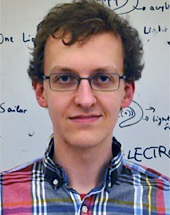Andrew Rzeznik, PhD

Like the light that reflects off the top of pool water, so do thin boundaries exist between layers of our atmosphere. Weather happens in the troposphere. One level higher is the stratosphere where air becomes warmer and calmer. Andrew researches gravity waves caused by air density at the boundary between the troposphere and stratosphere. His goal is to understand which waves traverse the boundary and which reflect off it. To date, there has been no unified mathematical model to do this. Andrew is trying to create a model that could be generalized to benefit earth-bound needs. For example, applications from his research could help make energy-efficient materials that hold heat when wanted and release it when not. The mathematical model might also aid design of fiber optics that increase speed of communication at lower cost.
Andrew “likes solving theoretical problems and building practical solutions.” During his first week as a freshman in Engineering Physics at Cornell, he joined a robotics team to design a submarine from scratch. Two meters long, it could recognize images, drop torpedoes, and find and grab a submerged pinging object and bring it to the surface. The team and its torpedo progressed from theory to Cornell’s swimming pool to the US Naval facility in San Diego where they won first place in international championships two years in a row.
“I tried all sorts of science classes as an undergrad and found that what tied them together was applied mathematics. Fluid mechanics is especially relevant to climate change and so different from the rest of engineering that I think I can contribute a lot.”